| Friday 8 Oct 1999 |
Got up at 3:30 AM and at 3:45 met Arturo who drove me to the airport in one of the seminary's VW vans. The Mexicans have a love affair with Volkswagens. They are everywhere, and most of the taxis are VW bugs, the old ones, with the right front seat removed. And I read that Mexico is one of the main centers for the production of the new VW bug.
We got to the airport very quickly compared to the hours-long trips across town earlier this week, and I was the first to go through security into the gate area where I powered up the laptop and started setting up a new section for Guatemala. The flight from Mexico City to Guatemala City was 1:45 hours on a 737. It was dark most of the way, and when it became light we were in clouds most of the time so my window seat didn't help me to see much of the Central American terrain as I was hoping. Sr. Arlene Trant met me at the airport and we waited a bit until Sr. Ann came and picked us up in a car and drove me to the Franciscan parish where I was staying with a group of Franciscan friars participating in an experiential part of their formation program. The parish is in a slum so typical of the Latin American scene in the big cities. The roads are full of potholes so deep that the frame often hits the ground. The buses are old US school buses pressed into service here, and they speed through the streets swerving around and through the potholes and belching thick diesel smoke. The church yard when we pulled in was a big muddy zone with deep puddles from the last shower a few hours before. There are six friars living behind the church, at the rear of the property on the edge of a deep tropical canyon full of thick foliage. They are from the Santa Barbara Franciscan province and stay for ten months here in Guatemala to learn about and experience poverty through living in the slum and working in various ministries. They learn about poverty first of all at home. St. Francis would be proud of them. The house we live in looks like a real log cabin from the front but it actually the outer slabs of tree trunks that are first cut off when trees are run through a saw mill. They are nailed to a framework of 2x4s that are set on the concrete slab where the house sets. The sides and back of the house are more wooden slabs or tin sheets nailed to the studs. The friars are a delightful bunch, in their late 20s, early 30s, and basically just arrived a month ago. They are studying Spanish and beginning various works where they can be of assistance. They gave me a warm welcome to the house and started telling me all the various standard operating procedures here, e.g.:
After getting me established with the friars and eating breakfast there (it felt like lunch to me since I had been up so long), I went over to the Maryknoll sisters' residence where four of them live about a ten minutes walk from the place I am staying. On the way we stopped at a small day care center run by the parish and then I met the parish priest, a Guatemalan whose first name is Dempsey. Not a common first name in the land of Juans and Miguels! At the sisters', I was able to check my e-mail. |
| Saturday 9 Oct 1999 |
This morning Arlene, Ricardo, and I met to plan more for the retreat, working mainly on logistics. Then in the afternoon Arlene and I met at the sisters' house where I focused more on learning the Guatemalan sign language that I will need. It is much easier learning a new sign language than a new spoken language because there are visual clues to help. And it's easier in this context because I will be giving presentations and can work with a limited vocabulary. In between the two sessions, I washed a load of clothes in the tubs outside because it had been so bright and sunny all morning. Of course as soon as I was ready to hang them up to dry, the clouds moved in.
I find it interesting that although I have never studied Spanish, I can read probably 75% of the signs and texts that I see here. I can't read 2% of the signs written in Chinese in Hong Kong after studying the language for 12 months in a university and speaking it for 12 years! One of the friars is named Ricardo and he has started working with Arlene with the Catholic deaf group. He was an RID interpreter in the US. Tonight the three of us met with four of the hearing volunteers and interpreters who also interpret mass at the cathedral on Sundays, etc., to talk about the retreat we will have on Sunday. We met in Pollo Campera, the Guatemalan equivalent of Kentucky Fried Chicken. The volunteers are delightful people, and talking about the retreat with them radically changed my ideas about how to approach it. Two of them, a couple named Mauro and Erika, had a car so they rode Arlene, Ricardo, and me home. It was about an hour's drive through the pot-holed streets from downtown to the slum area, and bouncing through the ruts and holes at 10:00 PM, the headlights of the car suddenly went out. Mauro drove with just his flashers all the way to Arlene's place where she got a flashlight and we checked the fuse box. Eventually we got the right headlight working and they started off toward home. We found out the next day they had become lost in the slum and didn't get home until almost midnight. |
| Sunday 10 Oct 1999 |
This morning Ricardo and I met Arlene at the basketball court that is a prominent landmark for us to catch our first bus to the retreat house there. The bus was soon jammed as we approached town. We used a center called Rosario and apparently it is basically a center for retreats and other similar gatherings and is quite nice. We had a big room we could divide with wooden panels.
We really had no idea how many people were going to the retreat because of the confusion surrounding last week's sign up, so we planned for 30, thinking we would be really lucky to get anywhere near that. It turned out we had 33 deaf people plus 9 volunteers and about 10 children of deaf parents. We started off with coffee and cake while they signed up, and then got underway. The theme for the day was reconciliation and the joy of being loved and forgiven by God, and our first activity was to dramatize the healing of the deaf man in Mark's gospel. After lunch which everyone brought and which we ate outside on the grass under the trees, we started a liturgy with a reconciliation service using the dramatizing of the healing of the deaf man again. Finally it was time to start the actual reconciliation service and we found we were close to our designated closing time so we had to negotiate with the center to allow us to leave at 5:00 PM instead of 4:00 PM. That part of the liturgy went well and was followed by a liturgy of the eucharist. We gave out little crosses as reminders of the retreat to everyone, and then I was surprised to receive a Guatemalan deaf association T-shirt and a Mayan design shirt. We were already past out extended deadline for leaving but went ahead and took some group photos, and finally got out the center front gates at 6:00. Mauro and Erika again graciously drove us across town. I went to the sisters' house and sent again some e-mails from the day before that had been rejected by my HK ISP. Apparently as a security measure, the Hong Kong server rejects some relays from foreign ISPs so the mail I was trying to send from my own address didn't go. I had the same problem when I was in Thailand last month. After resending the mail, I head home about 8:00 PM, and was just 20 steps from the friars' front door when the night skies opened and the rain REALLY poured. We were so fortunate that it didn't rain during the day! This trip to the US is mainly my home leave that Maryknoll gives us every three years, so now that the retreat is over, I am free and can start enjoying my time away from Hong Kong, with no other responsibilities! |
| Monday 11 Oct 1999 |
This morning Arlene picked me up at the friars' house at 9:00 AM and we took two buses downtown to see some of the sights of Guatemala City. First we went to a Dominican church that was extravagantly decorated for the month of October when Catholics traditionally pray special attention to the rosary. Hundreds of pilgrims were all around the church compound that was lined with vendors of religious articles and candles on one side.
Inside the church the first thing we did was to go around to a room behind the main altar where there is a stairway going up to a large statue of Mary that is mounted above the main altar and visible throughout the church. Apparently there is some special devotion connected with this statue and there was a long line of people waiting to climb to the platform where the statue is set in a glass enclosure. After a moment of prayer, they descend down a stairway on the other side of the platform, only they go down backwards to avoid turning their back to the statue! In the room below the statue is another one, life-sized, of Jesus falling as he carried the cross. It is brutally realistic and dramatic in showing the wounds he might have suffered. Then we went to the cathedral which is a traditional style with lots of side altars and alcoves for various saints' statues and a lot of oil paintings, probably brought over from Spain a couple hundred years ago. The most significant part of the cathedral are the columns supporting the wrought iron fence around the front entrance. They are engraved with thousands of names of those who disappeared, were massacred, and were tortured by the military government a few years ago. Across the plaza from the cathedral is the presidential palace and we walked through some of its courtyards and corridors. Really beautiful. This is where the peace process was signed on 29 December 1996, finally bringing peace to the country after a decade of suffering by the indigenous peoples. The memorial of the peace process is a pair of uplifted hands, sculpted in bronze as if they were closing in prayer. Between the hands is a rose which is ceremoniously changed each day at 11:30 AM by an honor guard. After a quick lunch at Wendy's, we headed home and I washed some clothes and then updated the home page. Elmer, the director of the formation program here, returned from Huehuetenango where he had been checking out a project the friars will work on next week. This evening there was a mouse in my room. I had seen several of them (or the same one several times) in the kitchen area and the corridor leading to the rooms, but this was the first time I saw one in my room. I tried to chase him out the door but he ran the other way instead, under my suitcases. They were closed but not latched, and I was just hoping that he didn't jump inside. I zipped them up and then got the mosquito net set up and was about to get in bed when I noticed a huge spider on the wall and whacked that. I didn't ask if it was a tarantula or not.
|
| Tuesday 12 Oct 1999 |
This morning Arlene and I met Sr. Helen at the Maryknoll Sisters' school about 45 minutes away in town, and then the three of us headed for the bus station for a trip to Quiche, to the west of Guatemala City. Three Maryknoll sisters live there in a contemplative community. We had been told there was what they call here a "Pullman" bus which is air conditioned and has assigned seats, but we couldn't find it so we walked through a market over to the regular bus terminus. The market was amazing with its color and variety, and I was wishing I had my camera out but we were hurrying to catch the bus and I didn't get any pictures.
It turned out we didn't have to hurry. We were lucky to get on the bus early and I got a seat by the window, but only about half the seats were full. But when we actually backed out of the bus area and started off, it took us 45 minutes to go the first 200 feet. The bus depot is a jammed mass of people and bus bays, and all departing buses must exit through one tiny lane. We just sat for 20 minutes at a time, breathing in the black diesel fumes from the mass of buses heading in every direction from the capital city. Finally we managed to get onto the highway and were soon climbing even higher up into the mountains. Before we got out of the city, our path was blocked several times by demonstrations of campesinos marching into the capital for a large protest rally. Groups marched on the city from all over Guatemala, some walking two or three days. The men would carry staffs and big three-foot machetes on their belts, and the women would be carrying large bundles on their backs and heads. Some were barefoot. They came to demand clear title to the lands where they live and farm. These regular buses are just old US school buses that have been given a new life as part of the Guatemalan transportation system. The one next to us still had "Duval County Schools" marked on its side, but most have been repainted in gaudy colors and with a saint's name on the front. The buses are designed to hold 32 school children, but we quickly started picking up more people heading for Quiche, and soon we had three adults in every seat, along with bundles of flowers, vegetables, and bags of every sort. Then the ten-inch aisle started filling up with standees (who would crouch down to pretend they were sitting whenever we went through a police check-point) until there were about 50 people inside the bus and huge mound of stuff stowed in a rack on top. The bus trip gave a beautiful view of Guatemala's hills and mountains and volcanoes and the people who inhabit them. Some areas of the city we passed through seemed relatively well-to-do, but soon we were among the little shacks of the poor people who inhabit and farm the land with simple hand tools. I didn't see any mechanized equipment like a tractor at all. Any everywhere women mostly were carrying large bundles of firewood on their backs, gathered from farther up on the mountain slopes. Little children would carry smaller bundles, supported by a tump line around their foreheads. We got off the bus at the little village of Lemoa after passing Lake Atitlan, one of Guatemala's scenic spots. In this little village three Maryknoll sisters have set up a contemplative prayer community in a house next to a parish church where mass is celebrated just once a month.
|
| Wednesday 13 Oct 1999 |
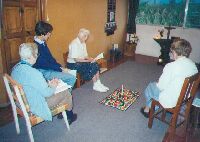 We had a 6:45 AM liturgy this morning in the sisters' small chapel with a large window overlooking the small lake below and the mountains in the distance and the corn on the hillside. Corn is the staple food for the Guatemalan people and figures prominently in their creation story in which their race is descended from the corn. I was surprised at the height of the corn here. Sometimes it is ten to twelve feet tall, much higher than I have seen it in the United States. They plant it differently also, four seeds to a little hillock. We had a 6:45 AM liturgy this morning in the sisters' small chapel with a large window overlooking the small lake below and the mountains in the distance and the corn on the hillside. Corn is the staple food for the Guatemalan people and figures prominently in their creation story in which their race is descended from the corn. I was surprised at the height of the corn here. Sometimes it is ten to twelve feet tall, much higher than I have seen it in the United States. They plant it differently also, four seeds to a little hillock.
We walked down to the road and waited maybe fifteen minutes before the "Guate" bus came chugging along. Arlene and I were lucky to get the last of the empty places to sit at the end of the seats, the third place on a two-person seat which means that you sit half on, half off the seat with your legs in the very narrow aisle.
Back in Guatemala City, we ate a quick lunch at Campera, the chicken place. This chain is all over Central America and has been successful where some of the other fast-food chains have not been because it adapted to local custom where men don't carry their own food to tables. Entering the restaurant, you go to a table and a waitress wearing a headset and wireless microphone comes and takes your order and radios it back to the kitchen to speed things up. Then she brings the food to the table. Only the take-out orders go straight to the counter. Coming back into the city brings you back into the gun culture here. Apparently because of high crime, guards with pistol-grip, pump-action shotguns are everywhere, standing outside every story and business. Even the Pepsi-Cola delivery trucks have a shotgun-toting guard riding along. It's rather unnerving to see so many weapons pointed in every direction by rather young kids. All the smaller shops, the little family mom and pop stores along the street have iron grills over the front, like a jail cell, so that you go up to the bars and ask for what you want, and it's passed through an opening in the bars. Elections for president are coming up soon and the campaign is in full swing. Thousands and thousands of candidates' pictures and slogans are on every tree and wall and bare rock along the highways. The people here tell me that the polls show a strong lead for the former military president under whom the majority of the massacres of the indigenous people took place. He is running under the banner of law and order. The human rights people are appalled at the prospect of his returning to office (he admits he himself killed two people in Mexico "in self defense" and fled the country because the "justice system is corrupt there"). One sister who works in a mental health situation helping people traumatized by the violence and massacres and torture says that she is not surprised since abused people often seek out abusers in a continuing cycle of violence. Tonight after supper I met with the friars as a group to discuss my work as a missioner and my ministry with deaf people. It was an interesting exchange for about 1 1/2 hours. During most of the time a mouse kept running along the counter, then climbing a curtain over the doorway, and going back along a board nailed along the wall. |
| Thursday 14 Oct 1999 |
This morning I washed more clothes and hurriedly hung them outside to get as much of the sun as possible before the afternoon rains came. Amazingly the pants I washed last night were dry enough this afternoon that I could put them on and wash the pants I was wearing. But then I dropped salad dressing on the clean pants an hour later! And tonight the rains started while I was away from home. Fortunately some kind soul moved my second pair of wet pants under the shelter, though.
Arlene, Ricardo, and I had a meeting this morning to discuss the future direction of the Catholic deaf group here. We all agreed that more workshops and retreats to help both the deaf group and the volunteers group define their identities more clearly would be really helpful. For lunch the Maryknoll Sisters invited me over to their house and that was delightful. I checked e-mail while there, and then Arlene and I walked to Upavim, a women's development cooperative where she tutors children after school. Started by a Texas lay woman, the center now has a clinic, a sewing factory, a day care center, and the tutoring program. The primary school kids who come for tutoring are really cute. The children here seem to be some of the most handsome and some of the warmest I have seen anywhere in the world. It's hard to think of them growing up to struggle for survival like their parents. And survival is a real struggle here.
This evening Barbara, the Upavim founder, had a farewell dinner for May at the center. There were just eight of us there and it was a really pleasant, really special meal. Two of the others were a husband and wife couple from Lexington, Kentucky who are volunteering through the VMM mission group, an ecumenical organization. It turns out the husband worked with my sister-in-law Hope in mental health programs in Kentucky. The rains were starting as I walked home about 9:00 PM and I wasn't totally unhappy because that meant there were fewer people on the streets although there were still plenty around. In the slums, people live a good part of their lives outside their tiny shacks and lean-tos. I haven't felt totally secure when I'm out alone, especially at night. A gringo like me really stands out. Yesterday something plopped on the street near me and I couldn't tell if it was something thrown by a group or teenagers or what. Today a young boy called out "Gringo" when I went by, but I don't think it was malicious, more just stating the obvious. One of the dangers of walking out at night is the danger of stepping into open manholes or huge holes in the streets and sidewalks. The potholes are huge and a lot of the traveling on foot is done in the streets. During the day, looking at the edge of the potholes, it's obvious that the streets are poorly paved to begin with, with very little foundation and a thin crust of asphalt. It's no wonder the paving breaks up under the constant pressure of the buses. The one good thing about the Guatemalan infrastructure is the large number of buses that are continuously plying the streets. Normally we never wait more than a minute or two for the next bus out of the Mezquital slum where we are |
| Friday 15 Oct 1999 |
Last night was another noisy night. The director of the house here gets up at 5:00 or 6:00 AM and starts setting up in the kitchen, and since there's only a piece of cardboard between the kitchen and my bed, I hear most of the pots and pans he moves around.
Arlene took me to the Maryknoll priests' residence in Zone 10 of Guatemala City. That's two bus rides and a long walk away from Zone 4 where Mezquital is. They just finished a four-day workshop there last night and most of the participants had left but I got to see a few of the Maryknoll people I had never met and a few others I had. One priest had served in China for several years but is now in Honduras. Two lay missioners from El Salvador were also there. We had not seen each other since their orientation program almost two years ago. We sat and chatted for a couple hours, mostly about the politics of Central America where it seems none of the governments care much about the people, especially the indigenous peoples. Then we had to leave for Arlene to get home in time for lunch. Today is the feast of St. Theresa, a special day for celebration for the Maryknoll sisters around the world.
Supposedly all these governments are democracies, but here that term "democracy" has a much different meaning from what we would understand in the US where we have the idea that we elect someone to represent us in the highest levels of government. Here it means that people can vote but only for a candidate who sees his position as an opportunity to create wealth for himself and who cares nothing about the people who elected him. In some of the Central American countries, a party is elected to power, not individual candidates, and the party picks the government ministers and delegates to the assembly. If they would vote against the party, maybe supporting the campesinos on some issue, the party just removes them since they are not elected by popular vote. The political systems are so rotten that it is easily understandable how communism and other promises of total social change are so attractive. A total social change, a real revolution, is what is needed. It would be nice if Christianity, if the church, was working to make that revolution happen. Some of its leaders are, but too many, though, are allied with the political powers against the people's interests. Pepsi definitely seems to have won the cola wars in Mexico and Central America. Their big blue delivery trucks are everywhere, and the fronts of most tiendra, or small shops, are painted Pepsi blue with the familiar logo. I haven't seen that many people drinking soft drinks, but there must be quite a market for them here. Coca-Cola has a large bottling plant here that we pass often on the buses. This evening the friars from the house in Bucaro, about fifteen minutes down the road away from town, came over for supper and prayer and fellowship. The two groups meet every Friday, and they are a pleasant bunch. I helped prepare the meal while the main group was in chapel, and then I washed dishes while the others sat at the table and chatted in Spanish. |
| Saturday 16 Oct 1999 |
This morning Arlene and May Chiu, from Hong Kong, came over to the friars' house where I'm staying and we took a bus down to an inter-city bus terminus to catch a bus to Antigua. A couple of the volunteers with the deaf group had talked of driving us there this morning, but we had heard nothing more about it so we headed out at 8:45 AM. I hadn't known May was coming but her plans for today had changed and she was free so Arlene invited her along. The bus was another of the crowded Guatemalan classics, but the ride was only an hour so it wasn't bad.
Antiqua is a beautiful old Spanish colonial town, maybe looking like something out of 19th-century Europe with the Spanish-style buildings, cobblestone streets, and a beautiful Mediterranean climate. Someone early on recognized its tourist potential and it is very much a touristy town now but not in the artificial sense. Everything there is authentic but has been developed for its potential for attracting visitors. We walked first through the central park and then to a Dominican church, the cathedral. I was amazed how small it was. A Franciscan brother who has been beatified--the first step toward being declared an official saint--is buried there. He is revered for his work with the poor in Guatemala. Then we walked to what I thought was another church because Arlene said we were going to Santo Domingo. It turned out to be a five-star hotel that has taken over an old monastery and church compound and transformed it into one of the most beautiful hotels I've ever seen. Most of public areas, even the reception desk, are open to the outside area, with no exterior walls. The reception desk is situated at a huge long table, not a counter, that looks like an old altar and behind it is the traditional tiered platform that was behind most pre-Vatican II altars. Statues of various saints are spread throughout the hotel and its courtyards and gardens, probably every one of them an antique from the 17th or 18th century. After a quick meal at a Burger King, we headed back to the bus terminus, stopping to get some Antigua bread on the way. Apparently everybody thinks that is some of the best in Guatemala so it was a welcome gift to the Franciscans back in Guatemala City. |
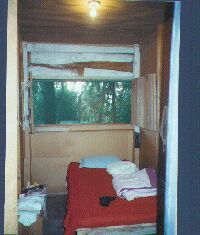 Inside, all the interior walls are cardboard, old refrigerator boxes and the like. It's amazing what you can do with old cardboard, and how nice it looks. Actually, the rooms next to mine probably look even better because I have the 2x4s showing in my room, whereas the rooms on either side would have just the cardboard surface. A window goes all the way across the 8-foot width of the room and can be covered with two large wooden shutters of rough-hewn lumber that looks like barn siding. Thank God there is a screen on the window although I still use a mosquito net at night. I was worried about that at first because before I came Arlene was warning me how fierce the mosquitoes are here. (She was right.)
Inside, all the interior walls are cardboard, old refrigerator boxes and the like. It's amazing what you can do with old cardboard, and how nice it looks. Actually, the rooms next to mine probably look even better because I have the 2x4s showing in my room, whereas the rooms on either side would have just the cardboard surface. A window goes all the way across the 8-foot width of the room and can be covered with two large wooden shutters of rough-hewn lumber that looks like barn siding. Thank God there is a screen on the window although I still use a mosquito net at night. I was worried about that at first because before I came Arlene was warning me how fierce the mosquitoes are here. (She was right.)
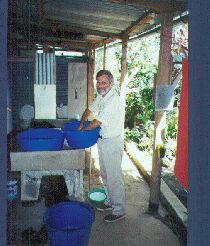 Then everything is hung on lines, some out in the open and some under the cover leading to the toilets. During the rainy season--August to November--it takes three to four days to dry things. So far I've been lucky. We've had some sunny mornings that have really helped the drying process. The worst part is leaving clothes out in the open during the afternoon rains and having to start all over again!
Then everything is hung on lines, some out in the open and some under the cover leading to the toilets. During the rainy season--August to November--it takes three to four days to dry things. So far I've been lucky. We've had some sunny mornings that have really helped the drying process. The worst part is leaving clothes out in the open during the afternoon rains and having to start all over again!
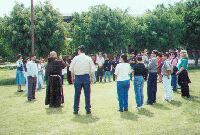 Then Arlene spoke about Jesus taking the deaf man apart to speak to him, about his healing touch, and then about the joy we feel when we are open to the touch of Jesus. Ricardo then led a meditation on identifying the presence of Jesus in our lives through our relationships with others. Mauro and Erika then helped identify and explain various sins and faults we could be guilty of, and the deaf groups then portrayed them in quick skits.
Then Arlene spoke about Jesus taking the deaf man apart to speak to him, about his healing touch, and then about the joy we feel when we are open to the touch of Jesus. Ricardo then led a meditation on identifying the presence of Jesus in our lives through our relationships with others. Mauro and Erika then helped identify and explain various sins and faults we could be guilty of, and the deaf groups then portrayed them in quick skits.
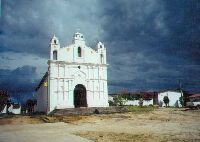 The Lemoa church is an old Spanish colonial style, very simply appointed with crude wooden benches and plain windows high up in the walls. Several statues are placed around the church, usually in glass cases, and several processional crosses and images to be carried were leaning against the walls inside.
The Lemoa church is an old Spanish colonial style, very simply appointed with crude wooden benches and plain windows high up in the walls. Several statues are placed around the church, usually in glass cases, and several processional crosses and images to be carried were leaning against the walls inside.
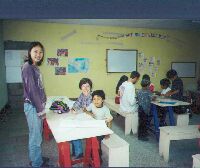 At the center I finally got to meet May Chiu, a Hong Kong young woman who worked for the HK Marine Police for six years, then resigned and went to Nepal to volunteer for six months. Then she came to Guatemala where she is helping with the same tutoring program Arlene is in. I really admire adventuresome young women like her who can leave the security of their jobs and families and take off alone to work in really hostile conditions. I invited her to come and speak to our HK Catholic deaf group when we both get back there.
At the center I finally got to meet May Chiu, a Hong Kong young woman who worked for the HK Marine Police for six years, then resigned and went to Nepal to volunteer for six months. Then she came to Guatemala where she is helping with the same tutoring program Arlene is in. I really admire adventuresome young women like her who can leave the security of their jobs and families and take off alone to work in really hostile conditions. I invited her to come and speak to our HK Catholic deaf group when we both get back there.
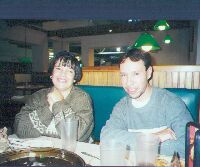 Once back in Guatemala City, we found out that the volunteers had called right after we left to take us to Antigua so we called them and arranged to meet them at a central Pizza Hut. We had a very nice gathering with just the two of them, a husband and wife. They gave me a couple of Guatemalan gifts to remember my time there, and then they drove us to Arlene's house. There they decided they wanted to videotape me signing to the deaf community so I made a two-minute greeting to the local people, and then they asked if I would do another that they could give to the local bishop to show him that there are priests who use sign language and work with the Catholic deaf community. The local volunteers have contacted the diocese there several times but haven't had much response to their request for more pastoral attention to the Catholic deaf people.
Once back in Guatemala City, we found out that the volunteers had called right after we left to take us to Antigua so we called them and arranged to meet them at a central Pizza Hut. We had a very nice gathering with just the two of them, a husband and wife. They gave me a couple of Guatemalan gifts to remember my time there, and then they drove us to Arlene's house. There they decided they wanted to videotape me signing to the deaf community so I made a two-minute greeting to the local people, and then they asked if I would do another that they could give to the local bishop to show him that there are priests who use sign language and work with the Catholic deaf community. The local volunteers have contacted the diocese there several times but haven't had much response to their request for more pastoral attention to the Catholic deaf people.